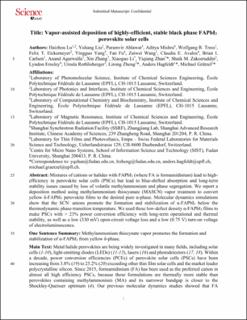Please use this identifier to cite or link to this item:
https://doi.org/10.21256/zhaw-20649| Publication type: | Article in scientific journal |
| Type of review: | Peer review (publication) |
| Title: | Vapor-assisted deposition of highly efficient, stable black-phase FAPbI3 perovskite solar cells |
| Authors: | Lu, Haizhou Liu, Yuhang Ahlawat, Paramvir Mishra, Aditya Tress, Wolfgang Eickemeyer, Felix T Yang, Yingguo Fu, Fan Wang, Zaiwei Avalos, Claudia E Carlsen, Brian I Agarwalla, Anand Zhang, Xin Li, Xiaoguo Zhan, Yiqiang Zakeeruddin, Shaik M Emsley, Lyndon Rothlisberger, Ursula Zheng, Lirong Hagfeldt, Anders Grätzel, Michael |
| et. al: | No |
| DOI: | 10.1126/science.abb8985 10.21256/zhaw-20649 |
| Published in: | Science |
| Volume(Issue): | 370 |
| Issue: | 6512 |
| Page(s): | eabb8985 |
| Issue Date: | 2020 |
| Publisher / Ed. Institution: | American Association for the Advancement of Science |
| ISSN: | 0036-8075 1095-9203 |
| Language: | English |
| Subject (DDC): | 621.3: Electrical, communications, control engineering |
| Abstract: | Mixtures of cations or halides with FAPbI3 (where FA is formamidinium) lead to high efficiency in perovskite solar cells (PSCs) but also to blue-shifted absorption and long-term stability issues caused by loss of volatile methylammonium (MA) and phase segregation. We report a deposition method using MA thiocyanate (MASCN) or FASCN vapor treatment to convert yellow δ-FAPbI3 perovskite films to the desired pure α-phase. NMR quantifies MA incorporation into the framework. Molecular dynamics simulations show that SCN- anions promote the formation and stabilization of α-FAPbI3 below the thermodynamic phase-transition temperature. We used these low-defect-density α-FAPbI3 films to make PSCs with >23% power-conversion efficiency and long-term operational and thermal stability, as well as a low (330 millivolts) open-circuit voltage loss and a low (0.75 volt) turn-on voltage of electroluminescence. |
| URI: | https://digitalcollection.zhaw.ch/handle/11475/20649 |
| Fulltext version: | Accepted version |
| License (according to publishing contract): | Licence according to publishing contract |
| Restricted until: | 2021-04-02 |
| Departement: | School of Engineering |
| Organisational Unit: | Institute of Computational Physics (ICP) |
| Appears in collections: | Publikationen School of Engineering |
Files in This Item:
| File | Description | Size | Format | |
|---|---|---|---|---|
| 2020_Lu-etal_Vapor-assisted-deposition-FAPbI3-perovskite-solar-cells_Science.pdf | Accepted Version | 286.4 kB | Adobe PDF |  View/Open |
Show full item record
Lu, H., Liu, Y., Ahlawat, P., Mishra, A., Tress, W., Eickemeyer, F. T., Yang, Y., Fu, F., Wang, Z., Avalos, C. E., Carlsen, B. I., Agarwalla, A., Zhang, X., Li, X., Zhan, Y., Zakeeruddin, S. M., Emsley, L., Rothlisberger, U., Zheng, L., et al. (2020). Vapor-assisted deposition of highly efficient, stable black-phase FAPbI3 perovskite solar cells. Science, 370(6512), eabb8985. https://doi.org/10.1126/science.abb8985
Lu, H. et al. (2020) ‘Vapor-assisted deposition of highly efficient, stable black-phase FAPbI3 perovskite solar cells’, Science, 370(6512), p. eabb8985. Available at: https://doi.org/10.1126/science.abb8985.
H. Lu et al., “Vapor-assisted deposition of highly efficient, stable black-phase FAPbI3 perovskite solar cells,” Science, vol. 370, no. 6512, p. eabb8985, 2020, doi: 10.1126/science.abb8985.
LU, Haizhou, Yuhang LIU, Paramvir AHLAWAT, Aditya MISHRA, Wolfgang TRESS, Felix T EICKEMEYER, Yingguo YANG, Fan FU, Zaiwei WANG, Claudia E AVALOS, Brian I CARLSEN, Anand AGARWALLA, Xin ZHANG, Xiaoguo LI, Yiqiang ZHAN, Shaik M ZAKEERUDDIN, Lyndon EMSLEY, Ursula ROTHLISBERGER, Lirong ZHENG, Anders HAGFELDT und Michael GRÄTZEL, 2020. Vapor-assisted deposition of highly efficient, stable black-phase FAPbI3 perovskite solar cells. Science. 2020. Bd. 370, Nr. 6512, S. eabb8985. DOI 10.1126/science.abb8985
Lu, Haizhou, Yuhang Liu, Paramvir Ahlawat, Aditya Mishra, Wolfgang Tress, Felix T Eickemeyer, Yingguo Yang, et al. 2020. “Vapor-Assisted Deposition of Highly Efficient, Stable Black-Phase FAPbI3 Perovskite Solar Cells.” Science 370 (6512): eabb8985. https://doi.org/10.1126/science.abb8985.
Lu, Haizhou, et al. “Vapor-Assisted Deposition of Highly Efficient, Stable Black-Phase FAPbI3 Perovskite Solar Cells.” Science, vol. 370, no. 6512, 2020, p. eabb8985, https://doi.org/10.1126/science.abb8985.
Items in DSpace are protected by copyright, with all rights reserved, unless otherwise indicated.